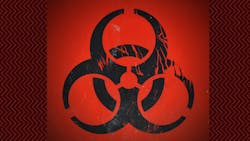4 infection control missteps to avoid
Have you observed questionable infection control practices in the dental setting? Dental care providers may need IC refreshers on IC practices and protocols throughout their careers. In fact, as providers we should stay current on IC recommendations and guidelines. The COVID-19 pandemic shed light on areas that need improvement to keep practitioners and patients safe. However, we should not wait for a pandemic to force us to review the basics; there is a risk of transmission of pathogens every day in dental practices.
In most states, IC continuing education is required to maintain licensure. Additionally, dental practices should review infection control protocols annually with their team. According to CDC guidelines, “Infection prevention policies and procedures are reassessed at least annually or according to state or federal requirements and updated if appropriate.”1
Here are some common IC best practices and potential areas for growth in your practice.
Hand hygiene
You may be thinking, I learned this on day one of my education and I don’t need to review something so basic. Well, in fact, it seems statistically, we do. Health-care providers’ lack of proper hand hygiene leads to health-care-related infections, and dental care providers are health-care providers.
Related articles
Infection control review: Common oversights from three perspectives
Instrument cassettes: What you shouldn’t be doing
Per the CDC, on average, health-care professionals perform proper hand hygiene fewer than half of the times they should.2 Reviewing proper hand hygiene techniques as a team can help prevent the spread of infection in the dental office. Research supports that improper hand hygiene routines is one of the leading causes of pathogen transmission in health-care settings. We can do our part in preventing this spread in the dental setting. According to the American Dental Association (ADA), dental health-care workers should wash their hands:
- anytime they treat a patient, both before and after
- anytime they put gloves on and immediately after removing them
- anytime bare hands have touched instruments, materials and/or equipment likely to be contaminated by blood, saliva, or respiratory secretions
- anytime they reglove or remove gloves that are torn, cut, or punctured
- anytime hands are visibly soiled
- before leaving the dental operatory3
Remember, alcohol-based hand rubs should be used in place of traditional hand washing if the hands are not visibly soiled.4 Also, focus on commonly missed areas such as thumbs, fingertips, and between fingers.5 Fingernails and nail polish have been hot topics in dental offices for a long time. Do your research and make an informed decision to determine if you will wear nail polish or have long nails in the dental setting. Chipped nail polish may support the growth of large numbers of organisms on fingernails.2 Even after careful handwashing or the use of surgical scrubs, personnel often harbor substantial numbers of potential pathogens in the subungual spaces.2
Data shows intact nail polish to be less likely to transmit pathogens. However, health-care workers who wear artificial nails are more likely to harbor gram-negative pathogens on their fingertips than are those who have natural nails, both before and after handwashing.2 As you likely learned in school, natural, short nails (less than one-quarter inch) are still the gold standard to reduce transmission of pathogens.6 Don’t share bugs with others or take them home with you! Hand hygiene is the most important measure to prevent the spread of infection among patients and dental health-care providers.7
Personal protective equipment (PPE) basics
Eyewear: Other commonly observed errors are lack of protective eye wear on both provider and patient for contaminant and eye injury prevention.8 Providers must wear OSHA-approved protective eyewear during procedures that are likely to generate splashes or sprays of blood or other body fluids.9
Garments: Protective clothing should include a long-sleeved jacket. OSHA’s Bloodborne Pathogens Standard 29 CFR 1910.1030 includes requirements for PPE,10 which is only considered appropriate if it does not permit blood or other potentially infectious materials to pass through to or reach an employee's work clothes, street clothes, undergarments, skin, eyes, mouth, or other mucous membranes under normal conditions of use and for the duration of time that the PPC will be used.11
Uniform: Don't touch your uniform! Observations in dental clinic settings have revealed practitioners touching uniforms, eye wear, face shields, masks, and more while wearing contaminated gloves. Not only do these errors occur during procedures but also while doffing PPE. Remember the proper order of removing PPC to avoid cross contamination.12
Sterilization
Seal those packages! Sterilization is defined as the process of complete elimination or destruction of all forms of microbial life.13 Many steps must be properly completed to obtain dental instrument sterility. A common error is failure to seal sterilization pouches. To properly sterilize instruments and maintain sterility after the sterilization cycle, it’s important to create a proper seal of the pouch. To do this, expose the adhesive and fold on the perforation, and press down to secure a complete seal. If the seal is not complete, it is not sealed properly. Folding the package over to save space, running, storing instruments unwrapped, or damaged packages do not maintain sterility. Therefore, patients could be exposed to pathogens gathered on these instruments. Review your sterilization packing instructions for use (IFU) and review with all staff members regularly.
Cold sterilization
Though the use of glutaraldehyde solution, called “cold sterilization,” seems to have drastically declined the past 10 years, there are still some dental practices using this for certain items. A consideration of the product’s IFU and care instructions is necessary when thinking about the use of a glutaraldehyde as a sterilant.
To get in the right frame of mind for this conversation, review the definition of sterilization. To use glutaraldehyde solutions as a sterilant, read the IFU. For example, here is the IFU from a popular glutaraldehyde solution: “Sterilant: 2.5% glutaraldehyde solution is a sterilant when used or reused, according to directions for use, at full strength for a maximum of 28 days at 25°C with an immersion time of at least 10 hours.”14 Keep in mind when each time a new item is added to the solution, you’re disrupting this 10-hour period, therefore, 10 hours restarts each time you introduce new contaminants to the solution.
If you believe the items you sterilize with glutaraldehyde cannot be autoclaved, I challenge you to review the care instructions for those items. You may be surprised to find they in fact can be autoclaved or they should be disposed of after use. There are few if any items that can only be sterilized through use of a glutaraldehyde solution.
If you have questions regarding IC best practices, do your research. A quick internet search can help you find evidence-based articles and manufacturer IFUs, which will help you determine the proper protocols to keep you and your patients safe. There are some areas of dentistry in which we are granted autonomy and creative control, but infection control is not one of those areas. Be your own advocate and throw up those red flags!
References
- Centers for Disease Control and Prevention. Guidelines for infection control in dental health-care settings—2003. MMWR Recomm Rep 2003;52(RR-17):1–61. www.cdc.gov/mmwr/PDF/rr/rr5217.pdf
- Centers for Disease Control and Prevention. Guideline for Hand Hygiene in Health-Care Settings: Recommendations of the Healthcare Infection Control Practices Advisory Committee and the HICPAC/SHEA/APIC/IDSA Hand Hygiene Task Force. MMWR 2002;51(No. RR16)
- Hand Hygiene for the Dental Team. American Dental Association, https://www.ada.org/publications/dental-practice-success/hand-hygiene-for-the-dental-team
- Hand Hygiene. Centers for Disease Control and Prevention. March 1, 2016 https://www.cdc.gov/oralhealth/infectioncontrol/faqs/hand-hygiene.html.
- Widmer AF, Dangel M. Alcohol-based hand rub: evaluation of technique and microbiological efficacy with international infection control professionals. Infection Control and Hospital Epidemiology. (2004)25;(3):207-209.
- Healthcare Providers. Centers for Disease Control and Prevention. January 8, 2021. https://www.cdc.gov/handhygiene/providers/index.html.
- Centers for Disease Control and Prevention. Summary of Infection Prevention Practices in Dental Settings: Basic Expectations for Safe Care. October 2016.
- Eye Safety in the Dental Office. American Dental Association, https://www.ada.org/resources/practice/practice-management/eye-safety-in-the-dental-office
- Standard Precautions. Centers for Disease Control and Prevention. June 18, 2018. https://www.cdc.gov/oralhealth/infectioncontrol/summary-infection-prevention-practices/standard-precautions.html
- Bloodborne Pathogens. Occupational Safety and Health Administration. May 14, 2019, https://www.osha.gov/laws-regs/regulations/standardnumber/1910/1910.1030
- What Are the Requirements for Clinical Lab Jackets in Dentistry? Organization for Safety, Asepsis, and Prevention, https://osap.memberclicks.net/what-are-the-requirements-for-clinical-lab-jackets-in-dentistry-
- Demonstration of Doffing (Taking Off) Personal Protective Equipment (PPE). YouTube. April 21, 2020. Accessed June 6, 2022. https://youtu.be/PQxOc13DxvQ
- Mohapatra S. Sterilization and Disinfection, Essentials of Neuroanesthesia (2017):929–944. doi:10.1016/B978-0-12-805299-0.00059-2
- Emergency and Technical Product Information. 2.5% Glutaraldehyde 28-DAY Sterilizing and disinfecting solution. Patterson Dental. https://content.pattersondental.com/items/PDFs/images/454192.pdf
About the Author

Megen Elliott, MS-OCL, RDH, CDA
Megen Elliott, MS-OCL, RDH, CDA, has more than 14 years of experience in the dental field. She’s an educator, author, interprofessional speaker, volunteer leader, and consultant. Megen is the program director of the dental assistant program at Northwood Technical College in Rice Lake, Wisconsin, where she’s also a faculty member. She’s a consultant with dental organizations and individuals, through talent acquisition and project management. Megen’s enjoys networking with dental colleagues online and at conferences. As the founder of Hygiene Happy Vibes, she encourages building each other up.
Updated October 24, 2022
